June 2022
The Forest Behind the Trees
Press secretary at Animat Habitat.
A Naturalist painting shares a new perspective. A unique perspective. Something that has not been seen before. A Naturalist painting does not just show another moose or yellow-bellied sapsucker… Another Amur tiger… Another North-Atlantic right whale. A Naturalist painting makes a statement of enough value to be worth making—to be worth the time that will be required to put paint on canvas and into perspective. There is a sense of environment or setting or space. The forest. The pines. And the air billowing between the trees.
Impressionism
There are many pathways into the art of painting, both stylistically and technically. I studied a range of styles, in particular nineteenth century Paris-based Impressionism, Soviet era Constructivism, and mid-twentieth century New York movements Abstract Expressionism and Abstract Impressionism. I realize that Realism is the style that resonates with me most as a painter and, as Robert ‘Bob’ Bateman would reason, as a Naturalist. Bob Bateman was one of the first to paint animals within a natural context. I look to his paintings as master works of a Naturalist style. And like Bob, I look to a history of abstract paintings to influence my compositions.
“I was interested in the distinction between trees as well as the mass of the form and color. I went back to Naturalism, but kept the Impressionism and Cubism as underlying concepts for picture ideas.”
— Robert Bateman, on the subject of Andrew Wyeth works at the Albright-Knox Gallery in Buffalo, New York, Robert Bateman: An Artist in Nature (1990) Madison Press Books
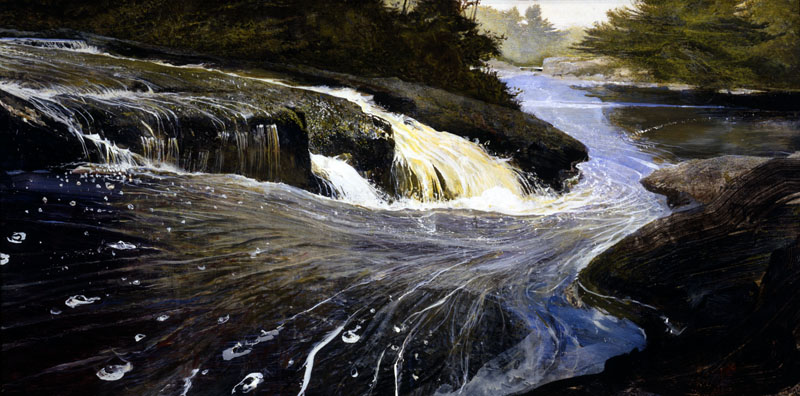
The Carry (2002) © Andrew Wyeth [andrewwyeth.com]
A painting represents a single moment in time. That moment in a Robert Bateman painting is, as William Whitehead narrates in the 1978 mini-documentary film about the Canadian artist and Naturalist for the National Film Board of Canada titled Images of the Wild, “a moment that could have happened but did not.” [1]
“A painting is made to look like before that moment was different and after that moment was different, because that is what nature is like.”
— Robert Bateman, Images of the Wild (documentary, 1978) National Film Board of Canada
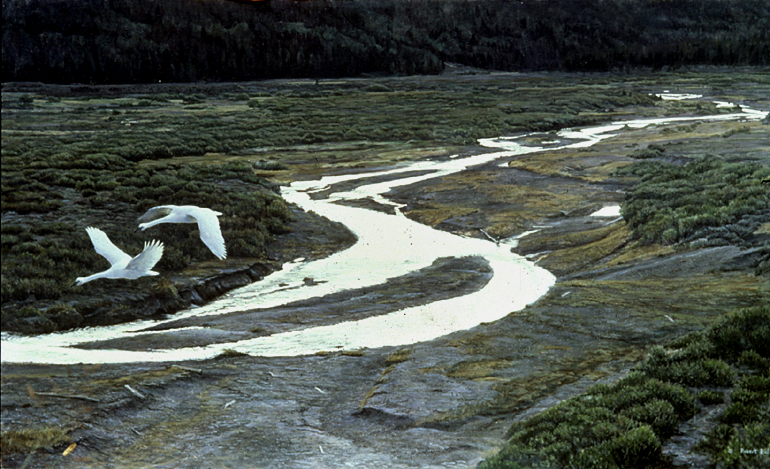
Above the River – Trumpeter Swans (1981) © Robert Bateman [robertbateman.ca]
Roger Tory Peterson, renowned Naturalist illustrator and author of a number of field guides to birds, has most eloquently elucidated the effect of an Andrew Wyeth painting as compared with a Robert Bateman painting:
“Wyeth nostalgically freezes the moment, holds on to it[.] It is a moment suspended forever. In contrast, Bateman's subjects are ready to go somewhere else, to fly away. His creatures are inevitably off-centred. They enter from off the canvas or are heading out toward the edge.”
This contrast was cited in an essay titled ‘An Ecological Artist’ in the book titled Robert Bateman: An Artist in Nature (1990) written by Rick Archibold. Archibold concludes in the essay how these two painters differed in their representation of time: “Wyeth makes time stand still. Bateman highlights its fleeting quality.” A moment later all the animals may be gone. [2]
While Bob Bateman is known for his paintings of animals, there is great attention to detail in the landscapes for those animals as well. In many paintings any animals are peripheral to the composition or almost imperceptible. A principle for Naturalist paintings, which I credit to Bob and I apply to my compositions, is that either the habitat or the animal takes precedence. Not both. When a message has a focus, its image has a focal point. Then almost every Naturalist painting becomes an exploration of nature, with a perceived pattern of color and shape.
“In a sense, it does not matter what the subject of a painting is, so long as there provides an opportunity for the eye to explore shapes and forms – concave and convex, positive and negative – as do the works of abstract artists. Art is an adventure for the eye. Although I care about scientific accuracy, I also look upon feather and fur as pattern, color, rhythm—elements of design.”
— Robert Bateman, New Works, ‘Artist's Statement’ (2010) Greystone Books
1 Lightfoot, Norman R. Images of the Wild (1978) National Film Board of Canada.
2 Archibold, Rick. Robert Bateman: An Artist in Nature (1990) Madison Press Books.
Abstract Impressionism
There are elements of Abstract Impressionism and Abstract Expressionism that carry into a Naturalist approach to painting animals and their natural habitats. Bateman describes his attempt at representing the shape of grass, “painting the form of the clumps of grass like a pan of muffins, shading each clump and then filling in the details in between.” This effect is achieved partly with an attention to light and shadow, and partly with just enough detail to create an illusion of reality. Your imagination is invited to fill in the rest.
This abstract approach is reminiscent of Oriental art styles that trace back to Taoist inspired art of the Song Dynasty (960-1279) with its visual themes of man set against nature. The art was rather colorless. Nonetheless the painterly compositions of large landscapes and small subjects have influenced Naturalist painters around the world for centuries. The teachings of Taoism advocate for following the ‘way’, or ‘path’, and integrating with the natural world. In the West, Taoism is commonly associated with a symbol. The Yang and Yin represents the balance of opposites and the concept of ‘qi’ as a natural energy running through all things.
“In this art, you see people and animals and trees and mountains and even air as being parts of one whole. Each element has a part to play, and man is just a tiny part of a great cosmos.”
— Robert Bateman, Robert Bateman: An Artist in Nature (1990) Madison Press Books
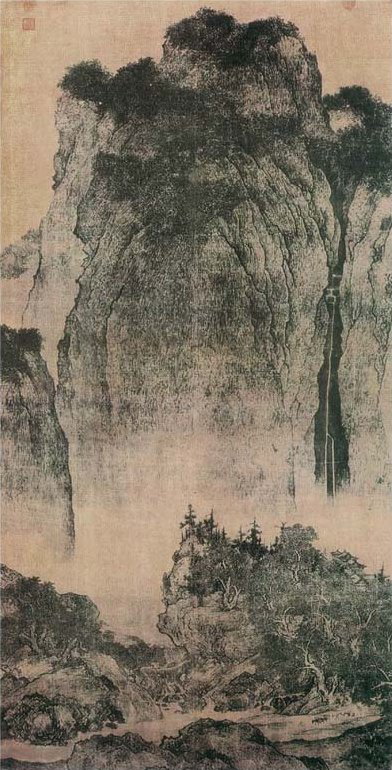
Travelers by Stream and Mountains, Song Dynasty (960-1279) by Fan Kuan
Light and shadow are fundamental in art. Taken to an extreme, some Abstract Expressionists simplified paintings to dark shapes on a light background or light shapes on a dark background. The balance between dark and light in some of these abstract paintings made it opaque whether the dark shapes superposed the light background or the other way around. The Yang and Yin.
For example the Abstract Expressionist Franz Kline was famous for bold calligraphic brush strokes projected onto white canvas. Abstract expressions of dark and light, like his, were reduced to a simple statement. However, paintings like these were renewed as an inspired trove for pictorial composition in many of the art movements that proceeded that of mid-twentieth century New York.
“The abstract language [Kline] wanted to pursue was figure on ground. […] Black on white, but then white back on top of the black, black back on top of the white again. It was an iterative process. A giving and going […] between these two colors.”
— Corey D'Augustine, In the Studio ‘The Painting Techniques of Franz Kline: Chief’ (2010) The Museum of Modern Art
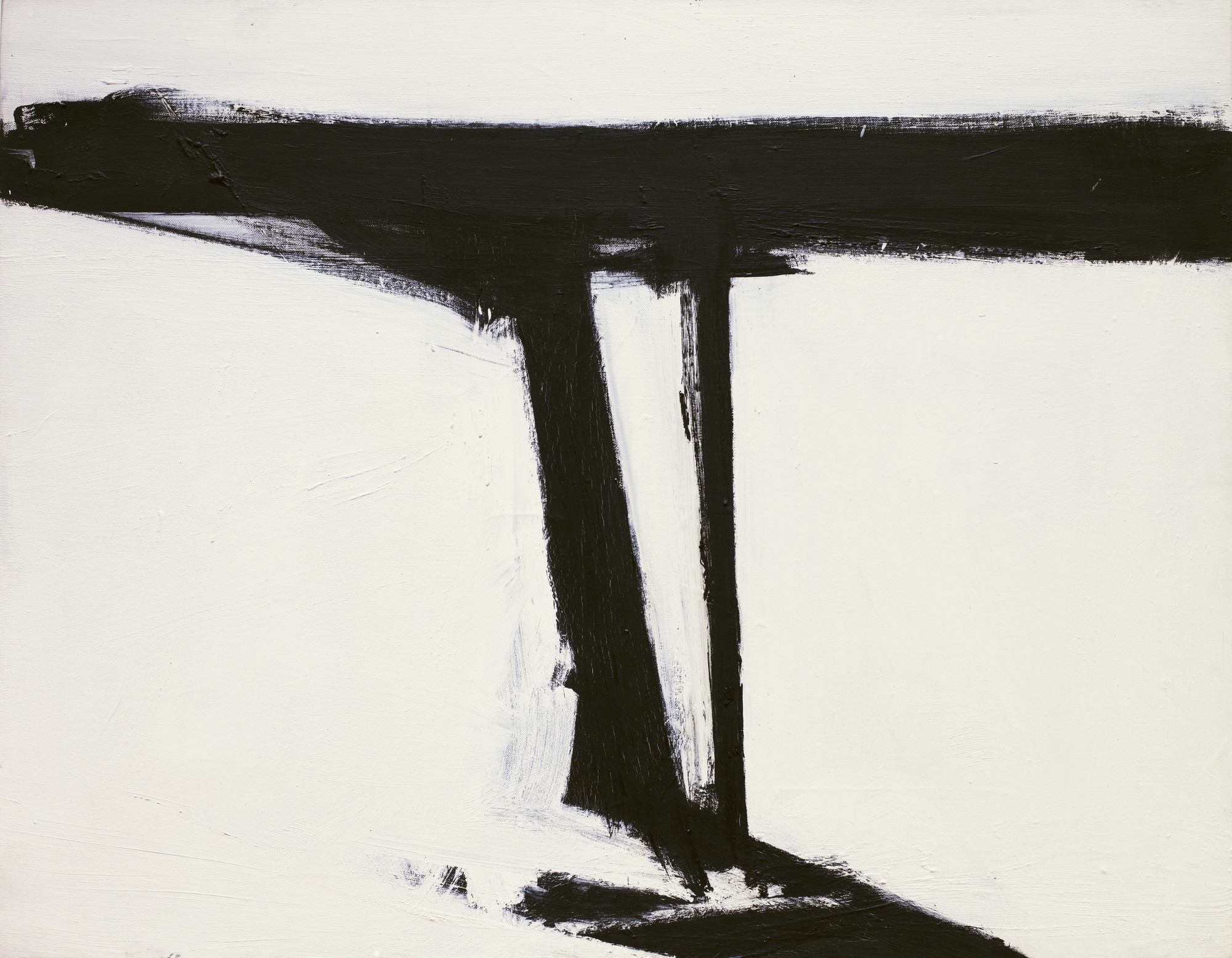
Le Gros (1961) by Franz Kline [moma.org]
This extreme of Abstract Expressionism is reminiscent of Chinese or Japanese calligraphy. Like the art of calligraphy, the texture of the brush strokes in Abstract Expressionist and Abstract Impressionist art has an intentionality. The thickness of the paint medium and the weight of each stroke adds a directional, textural aesthetic. These pronounced qualities almost preserve a record of movement in space and time. Like timelapse photography, there is an impression of motion. These paintings are often referred to as action paintings because the layered, textured appearance characterizes the painter in motion in front of the canvas. [3]
I look to appropriate these painterly aesthetics into a selection of studio works with cold wax and other impasto mediums and so on.
As part of The Beginning of Painting at Animat Habitat – building up to an oil painting of a tiger in the taiga – other works are underway. Of note is a diptych based on an abstract black-and-white pattern of vertical stripes. The stripes are mostly birch trees. The pattern of white trees and the spaces in-between will comprise the composition. The diptych is titled White Birch—an oil painting of a moose and a yellow-bellied sapsucker in the shade of a paper birch forest.
A low, diffuse light dimly reflects the white bark of paper birch trees on the fringes of the foreground. The light does not reach far into the forest—into the distance of the picture. The resulting picture is a pattern of dark and light with spaces where wildlife will blend in-between. A moose meanders through a shadowy mist at dawn. A sapsucker mulls over a spot to start the day. However, the animals in this picture are peripheral to the habitat. The forest habitat as a whole is the focus. The pattern of the trees.
This diptych is designed with a minimal palette, holding back on the use of color, and reducing the darks and lights to a pattern of mid-tones. This minimal palette is, in part, a technical exercise like Bob took on with Midnight – Black Wolf (acrylic color, 1989) and again with White Encounter – Polar Bear (acrylic color, 2005). Robert Bateman describes the challenge to paint most of a painting within a limited range of off-whites, “like a composition on a piano in four notes high in the tonal treble clef.“ And Midnight – Black Wolf was the opposite challenge, “to do most of the painting in four notes of the bass clef.” [4]
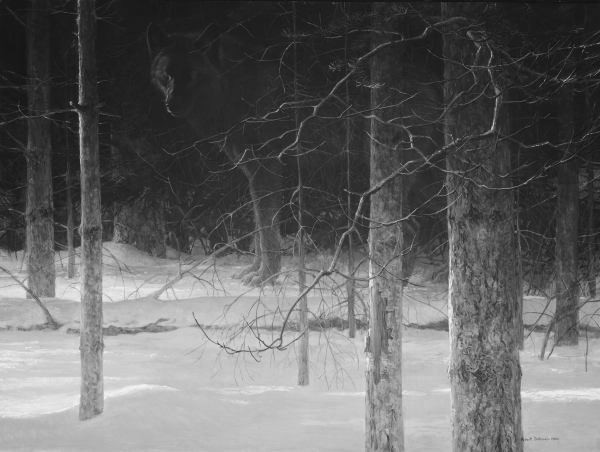
Midnight – Black Wolf (acrylic color, 1989) © Robert Bateman [robertbateman.ca, grayscale]
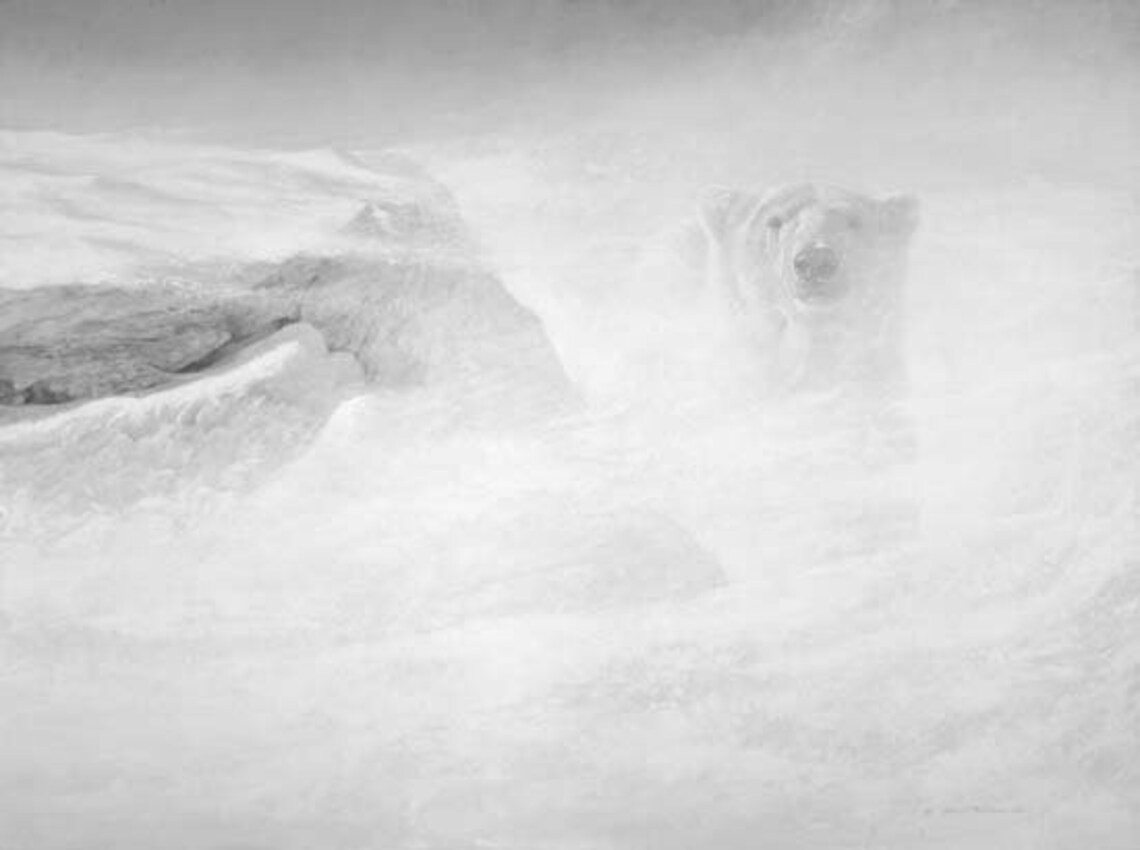
White Encounter (acrylic color, 2005) © Robert Bateman [robertbateman.ca, grayscale]
With all the dark tones in Midnight – Black Wolf (acrylic color, 1989), Bateman has admitted an air of menace and foreboding into this painting that is not present in his earlier paintings of wolves. While the tone may be subtle, in Robert Bateman: An Artist in Nature (book, 1990), in a final essay titled ‘Clean Air, Clean Water and the Song of a Bird’, author Rick Archibold notes that this painting represented a shift in the explicit nature of Bateman's messaging for nature. For Bob, each of his paintings clearly represent a celebration of nature whether any given statement is obvious or not.
“Like tigers, bears are being killed for their gallbladders and other body parts thought by some cultures to be medicinal. Polar bears are threatened by climate change. Elephants have been exterminated throughout much of the range because of the ivory in their tusks.”
— Robert Bateman, New Works (2010) Greystone Books
The message is not the only reason to paint a painting. Any painting can be a work of art. An impasto painting has the physicality to stand on its own aesthetic. For a Naturalist painter, however, the message is rarely far from the surface. For Robert Bateman, each painting in a way preserves a piece of a disappearing world. Bob concluded his ‘Artist's Statement’ in his new book New Works (2010):
“Perhaps, in some small way, I can raise the public consciousness about the value of those things that are vanishing and encourage people to protect our world for the future.”
3 D'Augustine, Corey. In the Studio ‘The Painting Technique of Franz Kline: Chief’ (2010) The Museum of Modern Art. Video Link
4 Bateman, Robert. ‘Bateman on Painting’ Website Link
The Forest
When painting a natural environment, for example a forest, what separates the trees from the forest is a sense of atmosphere. A misty morning. A dusty day. A partly opaque, particulated air that obfuscates or reflects the light source. This aesthetic appeals to Naturalist painters because of how mist or dust describes – and separates – the layers of a landscape.
Atmosphere is about space and the feeling of depth within that space. In a Naturalist painting there is depiction of the air—the vast volumes into the distance, the spaces between the trees, and the pathways through clumps of grass and so on.
Indeed this relates to painting birch trees in a morning mist. And indeed there is a painting of a birch forest as part of the beginning of painting at Animat Habitat. The feature painting for scene two at Animat Habitat, however, is made to tell the story of another forest: the taiga.
The boreal forest—the forest that dominates the far north, extending from Russia, across Europe, to North America is called the taiga where the Amur tiger is concerned. “During the winter,” as narrates Sir David Attenborough in the 2019 nature documentary mini-series Our Planet, in its episode titled ‘Forests’, which shows the taiga in winter, “the days are so short and the temperatures are so low that growth is at a standstill.” That far north, the forest supports very few animals. In that part of Siberia, one species of tree sustains all life. The pine tree. If the pine trees fail to fruit in season, deer and boar – any prey for a tiger – will move on.
“This is the home of an animal so rare, it is almost mythical. An Amur tiger. There are less than six-hundred of them. […] A male Siberian tiger patrols a territory of almost two-thousand square kilometres, and it has to do so if it is to find enough prey to keep itself alive through the long winter. This is an impoverished land, where food of any kind is scarce. […] Poaching has taken the Siberian tiger to the brink of extinction, but since the 1980s their numbers have slowly increased. [Their] future still depends on having vast areas of forest in which to hunt.”
— David Attenborough, Our Planet e/8: ‘Forests’ (2019) Netflix
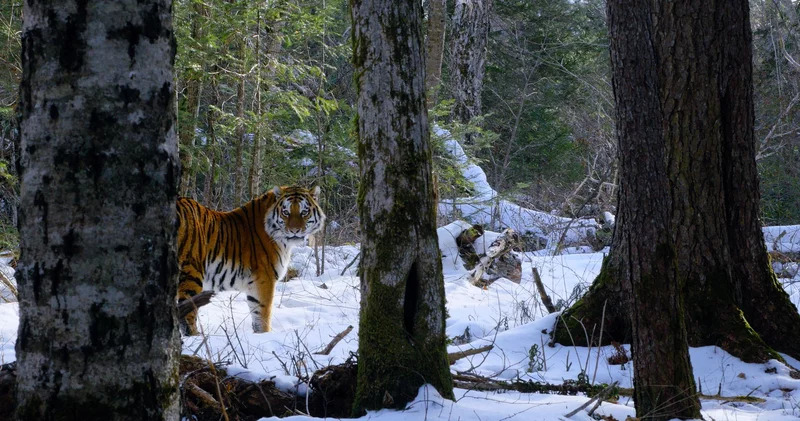
‘Amur tiger caught on camera trap in the boreal forests of Russia's Pacific Coast’ by Kieran O'Donovan, Our Planet e/8: ‘Forests’ (2019) © Silverback Films, Netflix [ourplanet.com]
Forests are our most precious natural resource. The Amazon rainforest and Congo rainforest are two of the most important wilderness areas we have today. There are many other forests on land and in the sea. The boreal forest however is estimated to hold hundreds of billions of trees with more than forty per cent of the carbon stored on Earth. Our forests are fundamental in the fight against climate change. [5]
Bob Bateman, in his book of ‘plates and commentaries’ published in 1990, Robert Bateman: An Artist in Nature, forewarned the importance of forests in the twenty-first century:
“Their continued destruction, whether in Europe, China, the Amazon or the Pacific northwest is one of the most serious challenges of conservationists. The amount of forest we have left by the beginning of the next century will have a lot to do with how livable our planet will be for our children and grandchildren.”
The same can be said of the twenty-second century. The same can be said of the next decade. Our inactions or insufficient actions to mitigate a mass extinction of biological diversity on this planet – our planet – has brought our very human world to the very brink of climate catastrophe.
The Trees
We need to plant trees. We need to make sure that trees grow. And making sure that trees grow is more complicated than planting them.
The problem however is with the economics and politics, not the logistics of planting trees. It is the problem with the extractive, myopic economic model of industrial aggriculture and industrial forestry and so on. Then there is the problem where in practice, and in policy, the environmental costs are too often overlooked.
Our best step forward is to stop cutting down the healthy forests we have today. This means law enforcement needs to put and end to illegal logging. Consumers with purchasing power need to boycott the companies that are driving deforestation. And we – and our political representatives – need to steward the rights of Indigenous peoples who have a history of being stewards of the natural world. Where there is opportunity for reforestation, local communities need to see benefits from any new forests because they will need to be invested in keeping those trees growing.

‘Canada's boreal forest’ [6]
As for painting a boreal forest for White Tiger, the pine trees are designed to appear in the background and appear blurred, bordering on Impressionism. There is a compressed sense of the spaces between the trees. The forest is altogether off in the distance. The layers of the forest catch the light en masse, and are designed to contrast with the deep colors and values of the subject in the foreground. In the midground there is atmosphere. This separation helps to flatten the focus of an otherwise Naturalist painting of a tiger to the tiger and to the eyes of the tiger and so on.
5 O'Donovan, Kieran. Our Planet (2019) Silverback Films, Netfilx Website Link
6 Galloway, Gloria. ‘Canada's boreal forest needs global protection…’ (2011) The Globe And Mail. Website Link